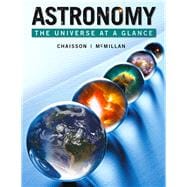NOTE: You are purchasing a standalone product; MasteringAstronomy does not come packaged with this content. If you would
like to purchase both the physical text and MasteringAstronomysearch for 0321792998 / 9780321792990 Astronomy: The Universe at a Glance Plus MasteringAstronomy with eText -- Access Card Package, 1/e: Package consists of:
- 0321799763 / 9780321799760 Astronomy: The Universe at a Glance, 1/e
- 0321977432 / 9780321977434 MasteringAstronomy with Pearson eText -- ValuePack Access Card -- for Astronomy: The Universe at a Glance, 1/e
MasteringAstronomyshould only be purchased when required by an instructor.
A modular and highly visual approach to introductory astronomy
Astronomy: The Universe at a Glance takes students on a spectacular journey across the vast cosmos. The Universe at a Glance introduces the structure and nature of the universe while emphasizing both the latest scientific findings and the process of scientific discovery. This new book by trusted authors Eric Chaisson and Steve McMillan reimagines their classic texts in a modularly organized, visual approach to learning. Here, the essential ideas, concepts, and discoveries of contemporary astronomy are presented in 15 chapters, each chapter composed of richly illustrated, two-page spreads designed to visually engage and instruct students.
Complete with spectacular graphics and concise, compelling chapters, The Universe at a Glance packs an immense amount of awe-inspiring insights into a brief modular volume. Uniting engaging prose, fascinating details, and easy-to-follow Learning Outcomes, this accessible account of astronomy is flexible and fun, an ideal complement to a dynamic introductory course. The text is integrated with MasteringAstronomy to create an unrivalled learning suite for students and instructors.
Also Available with MasteringAstronomy®
This title is also available with MasteringAstronomy – an online homework, tutorial, and assessment program designed to work with this text to
engage students and improve results. Interactive, self-paced tutorials provide individualized coaching to help students stay on track. With a
wide range of activities available, students can actively learn, understand, and retain even the most difficult concepts.
Students, if interested in purchasing this title with MasteringAstronomy, ask your instructor for the correct package ISBN and Course ID.
Instructors, contact your Pearson representative for more information.








